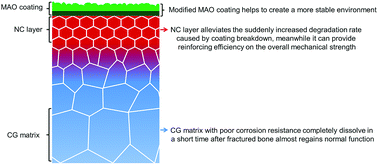Manipulating the degradation behavior and biocompatibility of Mg alloy through a two-step treatment combining sliding friction treatment and micro-arc oxidation
Abstract
Manipulating the degradation rate of biomedical Mg alloys has always been a challenge. In this study, a two-step treatment including sliding friction treatment (SFT) and micro-arc oxidation (MAO) was adopted to acquire a unique Mg-based architecture containing three typical layers comprising a MAO coating/nanocrystalline (NC) layer/coarse-grained (CG) matrix. It was found that the modified topmost MAO coating possessed enhanced corrosion resistance, cytocompatibility and hemocompatibility. The intermediate NC layer sandwiched between the coating and CG matrix was an ideal transition layer capable of avoiding degradation rate upsurge caused by coating breakdown; meanwhile, it provided an effective reinforcing effect on the overall mechanical strength. More importantly, the corrosion resistance of these layers was ranked in the order: MAO coating > NC layer > CG matrix. This kind of gradually increasing corrosion rate of the three layers with depth renders the two-step treatment a promising approach to design Mg-based implants possessing controllable degradation rates.



 Please wait while we load your content...
Please wait while we load your content...